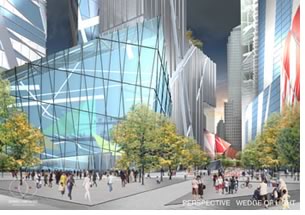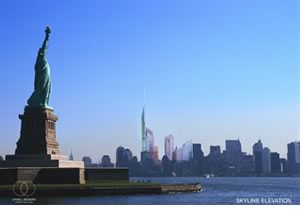

New York City officials announced February 27 that they unanimously chose Daniel Libeskind’s site plan for the World Trade Center, calling it a “compelling vision” that is both “breathtaking and practical.”
 “There
is still a long road ahead of us,” Lower Manhattan Development Corporation
Chair John Whitehead said, but lauded Libeskind’s plan as “the
best map with which to start the journey.” During a press conference
to announce the selection officially, Whitehead called the street plan
“ingenious.” The design offers a 1,776-foot spire, recalling
the year of the country’s independence, preserves the “bathtub”
(an area formed by concrete slurry walls that hold back the Hudson River)
for a museum and memorial, and embraces a performing arts center, transportation
hub, memorial park, five-star marquis hotel, and space for retail.
“There
is still a long road ahead of us,” Lower Manhattan Development Corporation
Chair John Whitehead said, but lauded Libeskind’s plan as “the
best map with which to start the journey.” During a press conference
to announce the selection officially, Whitehead called the street plan
“ingenious.” The design offers a 1,776-foot spire, recalling
the year of the country’s independence, preserves the “bathtub”
(an area formed by concrete slurry walls that hold back the Hudson River)
for a museum and memorial, and embraces a performing arts center, transportation
hub, memorial park, five-star marquis hotel, and space for retail.
Whitehead also called attention to an element of the design that would capture a slice of sunlight each year on Sept. 11, from the time that the first plane hit until the time the last tower fell. He also mentioned that Libeskind’s plan gives maximum flexibility for a memorial design competition, scheduled to begin this spring.
 “Forged
in democracy”
“Forged
in democracy”
A committee with representatives of the LMDC, the Port Authority of New
York and New Jersey, and the offices of the governor and the mayor opted
for Libeskind’s plan over that of the team known as THINK, which
was led by Rafael Viñoly and Frederic Schwartz. Nine proposals
for redeveloping the trade center site were unveiled Dec. 18. A second
design competition was launched after an initial set of plans, released
in July, was criticized for its emphasis on office space and retail requirements.
“It was born out of tragedy, but it was forged in democracy,” said New York Gov. George E. Pataki, who applauded the public’s role in commenting on the designs and the input and efforts of architects worldwide.
 Balancing
hope and memory
Balancing
hope and memory
Robert A. Ivy, FAIA, editor in chief of Architectural
Record, praised Libeskind’s plan during a February 27 interview
with CBS News in New York City, saying it “balanced hope and memory
by going down into the foundations of the original building itself. We
were able to recall what happened, all the tragedy, without being overwhelmed
by it.” He said the design “brings a new vision for the future
of the city.” In terms of the public process, Ivy noted: “We’re
at a great moment. We’re seeing design actually having captured
the public debate—people having been involved, caring, having their
voice heard.” Ivy noted that the design includes inspiring elements,
such as gardens at the top of the 1,776-foot tower that are meant to reaffirm
life. He cautioned that “how much of that will be built remains
to be seen.”
Libeskind, an immigrant born in Poland, came to this country in 1959 with his parents, both of whom survived the holocaust. During the press conference, he recalled his journey to America on the boat the U.S. Constitution, and the impact that first view of New York City’s skyline would have on him and his career. He said as an architecture student at Cooper Union he later watched the World Trade Center being built. He called his design’s selection “a profoundly moving moment.”
Copyright 2003 The American Institute of Architects.
All rights reserved. Home Page ![]()
![]()
 |
||
|
|
||